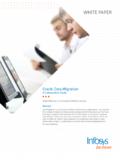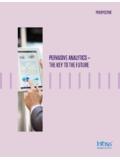Transcription of STUDY - Infosys
1 STUDYThe growth and maturity of digital channels have steadily increased the expectations of the consumers, who now look for an integrated shopping experience across all their touch points with a retailer be it an online comparison, a feedback from social media, a delivery system, or an in-store Infosys STUDY reveals retail insights from 1,000 consumers and 50 retailers across the United States. Key highlights include the need for consistency in brand interaction across channels, rising expectations for personalization among consumers, and how retailers are focusing on providing seamless omni-channel shopping RetailInsights from consumers and retailers into an omni-channel shopping experienceThe effect of consistency across retail organizationsA majority of consumers see consistency of numerous facets of retail operations as important across both physical and online stores and across different physical branches.
2 Consistency in the range of products available, is regarded as important, by 72% of respondents for physical and online stores and by 77% across different physical branches. Similarly, consistency in the location of / ease of finding products is important for 68% of respondents across physical and online stores and 75% of respondents across different branches. Consistency of customer service is important to a majority of consumers across physical and online (69%) and across different branches (74%), as are offers / promotions (68% physical and online; 71% across different branches) and appearance / branding of stores (64% physical and online; 66% across different branches).Less than two-fifths (39%) expect their personal information / purchasing history to be consistent across different branches of a brand, while a slightly higher number (44%) expect this across physical and online stores.
3 Despite this, a majority (86%) said that personalization has at least some impact on what they purchase, and one-quarter (25%) say personalization significantly influences what they over two-thirds (69%) of respondents say a retailers consistency across various channels affects their loyalty to a brand. Surveyed consumers are more likely to say that a high level of consistency would keep them loyal (44%) and a lack of consistency turning them off a brand (38%). More than three-fifths (62%) say consistency has an effect on their tendency to spend with a brand; consumers are more likely to say that a retail brands lack of consistency would see a reduction in spend (39%).Consumers59% of shoppers who have experienced personalization believe it has a noticeable influence on purchasingAlmost one-third (31%) of surveyed consumers wish their shopping experience was more personalized than it currently is.
4 Currently one-fifth (20%) have never experienced any kind of personalized offers / promotions based on previous purchases, while 19% have never experienced product recommendations based on previous of respondents (20%) have encountered personalized offers / promotions in-store while just over one-quarter (27%) have seen these online. Almost twice as many say they have experienced product recommendations based on previous purchases online (32%) compared to in-store (18%).Of those who have experienced personalization, the majority are highly in favor of personalized coupons (67%), personalized offers / promotions based on previous experiences (62%) and product recommendations based on previous purchases (58%). A majority (86%) of respondents who have experienced personalization say that this influences what they purchase to some extent, including one-quarter (25%) saying personalization significantly influences what they least half of all respondents are highly in favor of personalization for groceries (56%), entertainment (53%), health and beauty, (51%) and electronics (50%), while a significant proportion are highly in favor of personalization with regard to clothing (47%), pharmaceuticals (42%) and furniture / gardening / do-it-yourself (DIY) (41%).
5 PersonalizationDiscovering new products and impulse buyingA whopping majority of consumers surveyed (92%) look to discover new products. In fact, a majority discover new products via personal research (59%) and through advertising (58%). However, a majority of consumers (96%) also expect retailers to inform their customers of new products to some three-fifths of respondents (59%) interact with brands and/or retailers online. The two websites most commonly selected are Facebook followed closely by the brand / retailer website. Of those who interact with brands online, almost nine in ten (89%) say brand interaction has at least some impact on their purchasing majority of surveyed consumers (90%) admit to impulse buying at least occasionally. Half (50%) say they are more likely to impulse buy in-store, with less than one fifth (16%) saying they are more likely to do so of shoppers who engage with retailers via social media channels say those interactions have an impact on their purchasing choicesConsistency across retail organizationsA majority of surveyed retailers deliver consistency through a variety of aspects across both physical and online stores and different retail branches.
6 A fairly high level of consistency in the range of products available is delivered by more than half (56%) across physical and online stores and by 68% across retail branches. Other aspects vary across physical and online stores and different retail branches; consistency in appearance / branding of stores is currently delivered by 50% of surveyed retailers for physical and online stores, but by four-fifths (80%) across different physical branches. Similarly, just over half (56%) say offers / promotions are delivered consistently across physical and online stores; this increases to 78% across different two-thirds (64%) of surveyed retailers believe their consumers shopping experience should be more personalized. Despite this, less than half (48%) say information about customers purchasing history is consistent across physical and online stores and the same number (48%) say this is consistent across different majority of surveyed retailers (90%) believe consistency across their brand s engagement points has an effect on customer loyalty; the majority of interviewed retailers are more likely to say a high level of consistency would keep a customer loyal (70%) rather than a lack of consistency turning them off a brand (46%).
7 Similarly, a majority (92%) of retailers said that consistency has an effect on customers tendency to spend; surveyed retailers are more likely to say that high level of consistency would see an increase in customer spend (62%).Retailers90% retailers believe consistency across their brand s engagement points has an effect on customer loyaltyDespite almost one-fifth of surveyed retailers (18%) not having or planning any kind of personalization, a majority of surveyed retailers (96%) believe personalization influences what consumers purchase to some extent, with over half (56%) saying this significantly influences consumer two-thirds of surveyed retailers (62%) currently offer personalization and a further fifth are planning to implement this technology. Of those who offer personalization, almost half (48%) offer personalized offers / promotions based on previous purchases online, compared to only 3% in-store.
8 Similarly, only one in ten (10%) offer product recommendations based on previous purchases in-store but almost two-fifths (39%) offer this those who currently offer personalization, all (100%) have experienced at least one benefit from this technology. The four most commonly cited benefits are an increase in sales (74%), an increase in profit (61%), an increase in online traffic (58%) and an increase in customer loyalty (55%), all reported by the majority. Of those who are planning to introduce personalization, less than half (44%) would expect to see an increase in profit. The three most commonly reported answers are an increase in online traffic (89%), an increase in sales (67%), and an increase in customer loyalty (56%).PersonalizationConsumers are three times more likely to impulse buy in-store than onlineAlmost all surveyed retailers (98%) believe interaction has at least some impact on customers purchasing habits.
9 Similarly, a majority (92%) say their customers interact with their brand online. The two most common ways of doing this are via the brand / retailer website (80%) and Facebook (66%). Integrating the customer experience Seven in ten respondents (70%) have at least one factor preventing them from creating a more integrated customer experience within their organization, with lack of technology being the most common (38%). Nine in ten (90%) believe a single customer view is important to some extent, with over two-fifths (42%) saying this is very important. However, almost one-quarter (22%) of surveyed retailers do not currently go about creating a single customer view. This being said, Data collection and monitoringthe majority create a single customer view through clicks online (64%) and purchases across stores (54%). Monitoring trends Just over one-third (34%) currently monitor trends in real-time, while almost two-fifths (38%) are planning to do so.
10 Of those who currently monitor trends in real-time, a majority are able to monitor the products that are popular with a particular demographic (82%), products that are popular in a particular region (71%), and products which are popular online (71%). Almost nine in ten surveyed retailers (84%) collect consumer interaction data. On an average, 37% of consumer interaction data collected by retailers is used for upstream buying / assortment planning. Less than half (45%) of these retailers share this consumer information with of technology is the most common factor (38%) preventing retailers from creating a more integrated customer experience within their organization 2013 Infosys Limited, Bangalore, India. All Rights Reserved. Infosys believes the information in this document is accurate as of its publication date; such information is subject to change without notice.















